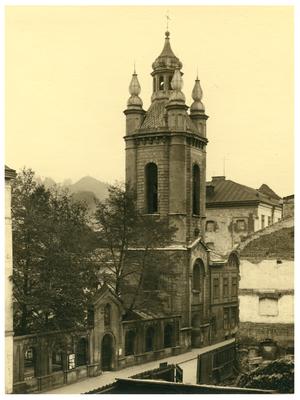Vul. Virmenska, 13 – former Muratowicz townhouse ID: 2335
The four-story residential house, known also as the Miros’ palace, was constructed in the late eighteenth century owing to the reconstruction of two older houses carried out by architects Piotr Połejowski and Pièrre Denis Guibaut. It is an architectural monument (protection number 319) which combines in its architecture the features of the Neoclassicist and Rococo styles. Now it is a residential house; some ground floor premises are occupied by the Cilicia café bar.
Story
Archaeological excavations were carried out in the yard between the houses 11 and 13 (the so-called Under the Cross yard) in 2000. During the excavations a part of a wooden defensive structure of the “princely age”, that is, the times of the Galician-Volhynian principality, was found, as well as cultural strata of the thirteenth-fifteenth centuries. This finding is just another confirmation of the supposition that there was a settlement in the place of Lviv before 1256.
In the fourteenth-seventeenth centuries two houses stood in the place of the house; Hovhanes Karmataniants (Iwan Muratowicz), the first Armenian printer in Lviv, lived in one of them. The house was designated as the Muratowicz’s one in tax payers lists of 1631, 1662 and 1767. The both houses fell into decay in the second half of the eighteenth century. In 1773 they were bought by architect Piotr Połejowski (Петро Полейовський) and became the possession of count Jozef Miro in 1778. In 1781-1783 the latter had the house reconstructed under a project drawn up by Pièrre Denis Guibaut. The look, which the house acquired owing to this reconstruction, has been in general outline preserved till our days. From 1857, there was the financial public prosecutor’s office in the house; in 1929-1933, the Religious Library Society; in 1933-1945, the Armenian Archdiocesal Union.
According to the resolution of the Council of Ministers of the Ukrainian SSR number 970 dated 24 August 1963, the house was entered in the National list of architecture and urban planning monuments under protection number 319.
Now this residential house is owned by the city. Some ground floor premises are occupied by the Cilicia café bar; two apartments were reconstructed to this purpose in 2000-2001. The second floor houses the Bazikalo hostel.
Architecture
The townhouse is situated in the historic center of Lviv. In the north, it is attached to the wing of the house number 16 on Lesi Ukrainky street. The two houses, located on a single parcel, were initially an integral structure, but were developed separately beginning from the seventeenth century.
Almost no traces of the house built in the seventeenth century and its predecessors have been preserved. Due to the stylistics which combines some Classicist features in the volume and space structure and some Rococo elements in the décor, it is possible to date the house to the late eighteenth century. This conclusion is also confirmed by written sources.
The rectangular four-story house belongs to the palace type; it is build of brick and plastered, has basements and a wing which adjoins it from the north. A passage leads through an entrance arch to a chamber yard. A spacious staircase is made in the western wing of the house. The internal planning is sectional; the wing has a gallery-like structure.
In the main façade composition, a typical for the Neoclassicist style plane distribution symmetry is combined with Rococo decorative elements. The façade is divided vertically by seven window axes. The central part is marked out by a three-axis projection which is accentuated by a wide balcony with a delicate railing and putti figures placed on platforms. The balcony plate is supported by stone consoles; windows and doors are crowned with segments that have raised insertions. The rest of the second and third floors windows have framings with segmental pediments; the ground floor windows have keystones in the shape of consoles. Rocaille elements decorate the cut corner of the house from the south-west. Corners like this were typical for the late eighteenth century. The façade is crowned with a large protruding cornice. There are galleries along the back façade and along the wing.
The internal space is opened by a wide gate bridged with a lunette vault. The floor is covered with Zuliani ceramic tiles dated 1909. The premises adapted to function as a café bar are located in the western part of the house. In general, the house has preserved the features characteristic of the Lviv architecture of the late eighteenth century.
People
Hovhanes Karmataniants (Iwan Muratowicz, Iwan (Jan) Keremowicz, Iwan (Jan) Karmatents) (c. 1590-1624) – an Armenian printer, the house owner.Jozef Miro – a councillor of State, count, the house owner.
Maciej Połejowski (Матвій Полейовський)– a Lviv sculptor.
Piotr Połejowski (Петро Полейовський, 1734-1776) – a Lviv architect.
Pièrre Denis Guibaut (1740-1830) – a Lviv architect.
Sources
- State Archive of Lviv Oblast (DALO) 2/1/1191. The file was renamed: DALO 2/1/1167. URL: https://e.archivelviv.gov.ua/file-viewer/227946#file-731436
- Scientific-Technical Archive of "Ukrzakhidproektrestavratsia" Institute (ukr. "Укрзахідпроектреставрація"). Item # Л-361-7.
- Scientific-Technical Archive of "Ukrzakhidproektrestavratsia" Institute (ukr. "Укрзахідпроектреставрація"). Item #Л-361-1.
- Володимир Вуйцик, "Матеріали до історії кам'яниць вулиці Вірменської", Вісник інституту Укрзахідпроектреставрація, 2004, №14, 156.
- Мирон Капраль, Національні громади Львова XVI–XVIII ст. (Соціально-правові взаємини), (Львів: Піраміда, 2003), Карта 1.
- Наталія Космолінська, "У Львові зруйновано ще одну пам'ятку архітектури", Поступ, 2000, №170 (614).
- Памятники градостроительства и архитектуры УССР, Т. 3 (Киев: Будівельник, 1985), 18.
- Роман Липка, Ансамбль вулиці Вірменської, (Львів: Каменяр, 1983), 42-43.
- Тетяна Трегубова, "Реконструкція розпланування середньовічного Львова за письмовими джерелами", Архітектурна спадщина України, 1996, №3, Ч. 2, 27. [The author cites the following sources: CDIAL 52/1/777, CDIAL 52/1/783, CDIAL 52/1/812].
- Ярослав Дашкевич, "Вірменське друкарство у Львові 1616–1618 рр.", Галицька брама, 1996, №21-22.









